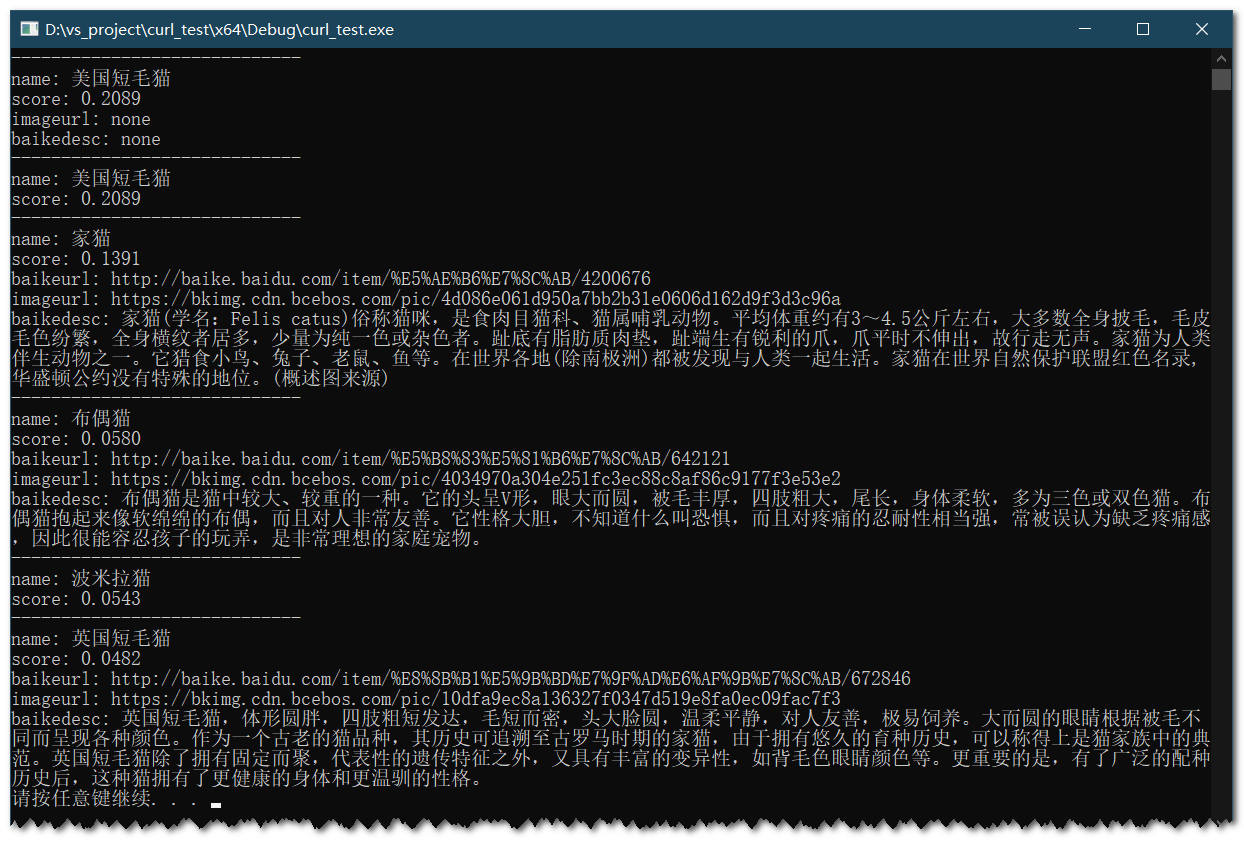(简单调用篇 03) 动物识别 - C++ 简单调用
动物识别能够识别近八千种动物,接口返回动物名称,并获取百科信息,适用于拍照识图类APP中。
- 拍照识别:根据拍摄照片,识别图片中动物的名称,可配合其它识图能力对识别的结果进一步细化,提高用户体验,广泛应用于拍照识图类APP中
用于识别一张图片,即对于输入的一张图片(可正常解码,且长宽比较合适),输出动物识别结果。
- HTTP 方法:
- 请求 URL:
- URL参数:
- Header 参数: =
- Body 参数:见下表
| 参数 | 是否必选 | 类型 | 默认值 | 说明 |
|---|---|---|---|---|
| image | 是 | string | - | 图像数据, 编码,要求 编码后大小不超过 4M,最短边至少 ,最长边最大 , 支持 格式 。注意:图片需要 编码、去掉编码头后再进行 |
| top_num | 否 | integer | 6 | 返回预测得分 top 结果数,默认为 6 |
| baike_num | 否 | integer | 0 | 返回百科信息的结果数,默认不返回 |
返回参数如下表:
| 字段 | 类型 | 是否必选 | 说明 |
|---|---|---|---|
| 是 | id,用于问题定位 | ||
| 是 | 识别结果数组 | ||
| + | 是 | 动物名称,示例:蒙古马 | |
| + | 是 | 置信度,示例:0.5321 | |
| + | 否 | 对应识别结果的百科词条名称 | |
| ++ | 否 | 对应识别结果百度百科页面链接 | |
| ++ | 否 | 对应识别结果百科图片链接 | |
| ++ | 否 | 对应识别结果百科内容描述 |
返回示例如下:
{ |
这里假设已经将环境配置好了,环境配置的文章可以参考 Windows 下使用 Vcpkg 配置百度 AI 图像识别 C++开发环境(VS2017)。
为了方便,首先根据返回参数定义了一个结构体,该结构体包括了返回参数中的参数,如下:
struct AnimalInfo { |
在 结构体中,定义了一个 方法以打印获取的结果。
然后定义了一个类来调用接口并获取结果
class Animal |
类中的私有成员 表示返回结果对应的 json 对象。 表示请求的 url, 表示请求参数中对应的 topnum,`filenameaccess token` 的文件的文件名。
函数输入请求图像的 base64 编码以及请求参数,返回一个 json 对象,json 对象中包含请求的结果。
获取请求的结果,总共有 top_num 条结果。
获取 score 最高的一条结果。
完整代码如下
和 代码参见 (简单调用篇 01) 通用物体和场景识别高级版 - C++ 简单调用
代码如下:
|
代码如下:
|
代码如下:
|
测试图像


栏 目:PHPCMS
本文标题:(简单调用篇 03) 动物识别 - C++ 简单调用
本文地址:http://028ta.com/index.php?m=home&c=View&a=index&aid=347
您可能感兴趣的文章
- 06-14java web应用实现扫码枪获取信息
- 06-14如何在iPhone上使用声控拍照?
- 06-01拍照识万物手机版
- 06-0120万高薪专业-网络安全(非常详细)零基础入门到精通,收藏这一篇就够了
- 05-07免费下载拍照识花软件
- 05-07iOS手机扫描识别名片技术
- 04-11有没有什么手机软件可以识别物体颜色?
- 04-11哪里可以买2维码软件啊?哪些app可以扫二维码
- 03-18自动化植物识别算法的性能将得到进一步提高
- 03-184020 万像素的 APS-C 相机:富士 X-H2 国行价格出炉,单机身 13390 元


阅读排行
推荐教程
- 11-22phpcms如何使用水印功能
- 08-12英雄联盟手游翡翠段位相当于王者什么水平_2
- 05-21电视剧《海上繁花》免费在线观看高清完整版
- 02-17《繁花(沪语版)》13在线免费观看
- 11-26星眼快递单条码扫描识别自动拍照出库软件3.5(免费版)
- 03-12《繁花》什么时候上映?
- 04-15纸上繁花
- 04-22王家卫首部电视剧《繁花》中都出现了哪些明星?
- 04-29手机内存整里优化对手机有什么好处和坏处
- 02-28唐嫣产后复工首部作品《繁花》路透曝光,时隔多年与胡歌再次合作






